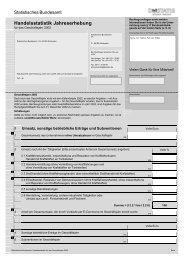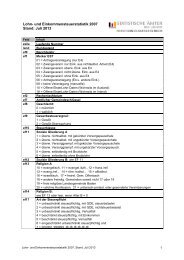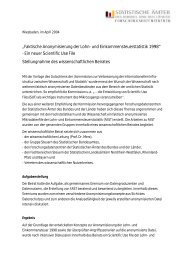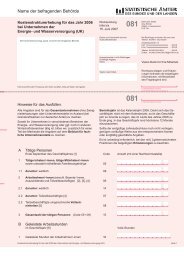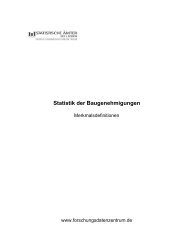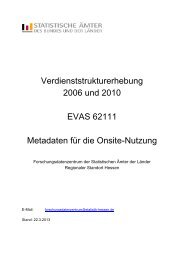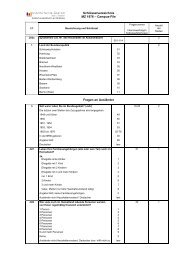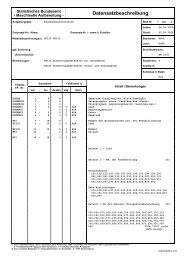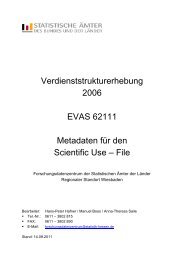The Research Potential of New Types of Enterprise Data based on ...
The Research Potential of New Types of Enterprise Data based on ...
The Research Potential of New Types of Enterprise Data based on ...
You also want an ePaper? Increase the reach of your titles
YUMPU automatically turns print PDFs into web optimized ePapers that Google loves.
FDZ-Arbeitspapier<br />
Nr. 27 31<br />
<str<strong>on</strong>g>The</str<strong>on</strong>g> <str<strong>on</strong>g>Research</str<strong>on</strong>g> <str<strong>on</strong>g>Potential</str<strong>on</strong>g> <str<strong>on</strong>g>of</str<strong>on</strong>g> <str<strong>on</strong>g>New</str<strong>on</strong>g> <str<strong>on</strong>g>Types</str<strong>on</strong>g> <str<strong>on</strong>g>of</str<strong>on</strong>g> <str<strong>on</strong>g>Enterprise</str<strong>on</strong>g> <str<strong>on</strong>g>Data</str<strong>on</strong>g><br />
<str<strong>on</strong>g>based</str<strong>on</strong>g> <strong>on</strong> Surveys from Official Statistics in Germany.<br />
Joachim Wagner<br />
2009<br />
STATISTISCHE ÄMTER<br />
DES BUNDES UND DER LÄNDER<br />
FORSCHUNGSDATENZENTREN
Impressum<br />
Herausgeber: Statistische Ämter des Bundes und der Länder<br />
Herstellung: Informati<strong>on</strong> und Technik Nordrhein-Westfalen<br />
Mauerstraße 51, 40476 Düsseldorf • Postfach 10 11 05, 40002 Düsseldorf<br />
Telef<strong>on</strong> 0211 9449-01 • Telefax 0211 442006<br />
Internet: http://www.it.nrw.de<br />
E-Mail: poststelle@it.nrw.de<br />
Fachliche Informati<strong>on</strong>en<br />
zu dieser Veröffentlichung:<br />
Forschungsdatenzentrum der<br />
Statistischen Ämter der Länder<br />
– Geschäftsstelle –<br />
Tel.: 0211 9449-2876<br />
Fax.: 0211 9449-8087<br />
forschungsdatenzentrum@it.nrw.de<br />
Erscheinungsfolge: unregelmäßig<br />
Erschienen im Oktober 2009<br />
Informati<strong>on</strong>en zum Datenangebot:<br />
Statistisches Bundesamt<br />
Forschungsdatenzentrum<br />
Tel.: 0611 75-4220<br />
Fax: 0611 72-3915<br />
forschungsdatenzentrum@destatis.de<br />
Forschungsdatenzentrum der<br />
Statistischen Ämter der Länder<br />
– Geschäftsstelle –<br />
Tel.: 0211 9449-2876<br />
Fax: 0211 9449-8087<br />
forschungsdatenzentrum@it.nrw.de<br />
Diese Publikati<strong>on</strong> wird kostenlos als PDF-Datei zum Download unter www.forschungsdatenzentrum.de<br />
angeboten.<br />
© Informati<strong>on</strong> und Technik Nordrhein-Westfalen, Düsseldorf, 2009<br />
(im Auftrag der Herausgebergemeinschaft)<br />
Fotorechte Umschlag: © artSILENCEcom – Fotolia.com<br />
Vervielfältigung und Verbreitung, nur auszugsweise, mit Quellenangabe gestattet. Alle übrigen Rechte bleiben<br />
vorbehalten.<br />
Bei den enthaltenen statistischen Angaben handelt es sich um eigene Arbeitsergebnisse des<br />
genannten Autors im Zusammenhang mit der Nutzung der Forschungsdatenzentren. Es handelt sich<br />
hierbei ausdrücklich nicht um Ergebnisse der Statistischen Ämter des Bundes und der Länder.
FDZ-Arbeitspapier<br />
Nr. 31<br />
<str<strong>on</strong>g>The</str<strong>on</strong>g> <str<strong>on</strong>g>Research</str<strong>on</strong>g> <str<strong>on</strong>g>Potential</str<strong>on</strong>g> <str<strong>on</strong>g>of</str<strong>on</strong>g> <str<strong>on</strong>g>New</str<strong>on</strong>g> <str<strong>on</strong>g>Types</str<strong>on</strong>g> <str<strong>on</strong>g>of</str<strong>on</strong>g> <str<strong>on</strong>g>Enterprise</str<strong>on</strong>g> <str<strong>on</strong>g>Data</str<strong>on</strong>g><br />
<str<strong>on</strong>g>based</str<strong>on</strong>g> <strong>on</strong> Surveys from Official Statistics in Germany.<br />
Joachim Wagner<br />
2009
<str<strong>on</strong>g>The</str<strong>on</strong>g> <str<strong>on</strong>g>Research</str<strong>on</strong>g> <str<strong>on</strong>g>Potential</str<strong>on</strong>g> <str<strong>on</strong>g>of</str<strong>on</strong>g> <str<strong>on</strong>g>New</str<strong>on</strong>g> <str<strong>on</strong>g>Types</str<strong>on</strong>g> <str<strong>on</strong>g>of</str<strong>on</strong>g> <str<strong>on</strong>g>Enterprise</str<strong>on</strong>g> <str<strong>on</strong>g>Data</str<strong>on</strong>g> <str<strong>on</strong>g>based</str<strong>on</strong>g> <strong>on</strong> Surveys from<br />
Official Statistics in Germany *<br />
Joachim Wagner **<br />
Leuphana University Lueneburg and IZA, B<strong>on</strong>n<br />
[This versi<strong>on</strong>: August 11, 2009]<br />
To be presented at the Annual Meeting <str<strong>on</strong>g>of</str<strong>on</strong>g> the<br />
German Ec<strong>on</strong>omic Associati<strong>on</strong>, Magdeburg, September 8-11, 2009<br />
Abstract<br />
A new generati<strong>on</strong> <str<strong>on</strong>g>of</str<strong>on</strong>g> data sets became available recently in the research data centres <str<strong>on</strong>g>of</str<strong>on</strong>g> the German<br />
statistical <str<strong>on</strong>g>of</str<strong>on</strong>g>fices. <str<strong>on</strong>g>The</str<strong>on</strong>g>se new data combine informati<strong>on</strong> for firms gathered in different surveys (or from<br />
other sources) that could not be analyzed jointly before. This paper <str<strong>on</strong>g>of</str<strong>on</strong>g>fers a short descripti<strong>on</strong> <str<strong>on</strong>g>of</str<strong>on</strong>g> these<br />
data, and gives examples <str<strong>on</strong>g>of</str<strong>on</strong>g> their use to dem<strong>on</strong>strate their research potential. Furthermore, and looking<br />
ahead to the next generati<strong>on</strong> <str<strong>on</strong>g>of</str<strong>on</strong>g> data, it discusses an <strong>on</strong>going project, KombiFiD, that will for the first time<br />
<str<strong>on</strong>g>of</str<strong>on</strong>g>fer access to linked firm level data collected by different data producing public instituti<strong>on</strong>s.<br />
JEL classificati<strong>on</strong>: C8<br />
Keywords: <str<strong>on</strong>g>Enterprise</str<strong>on</strong>g> data, Germany, research data centres<br />
* Thanks to Nils Braakmann and Alexander Vogel for critical remarks <strong>on</strong> an earlier versi<strong>on</strong>.<br />
** Pr<str<strong>on</strong>g>of</str<strong>on</strong>g>. Dr. Joachim Wagner, Leuphana University Lueneburg, Institute <str<strong>on</strong>g>of</str<strong>on</strong>g> Ec<strong>on</strong>omics, P.O. Box 2440, D-21314 Lüneburg, e-mail: wagner@leuphana.de<br />
Statistische Ämter des Bundes und der Länder, Forschungsdatenzentren, Arbeitspapier Nr. 31 1
1. Introducti<strong>on</strong><br />
When the Federal Statistical Office and the statistical <str<strong>on</strong>g>of</str<strong>on</strong>g>fices <str<strong>on</strong>g>of</str<strong>on</strong>g> the German federal states opened research<br />
data centres (described in detail in Zühlke et al. 2004) in 2001 and 2002 a new era started for researchers<br />
working in empirical ec<strong>on</strong>omics. Access to c<strong>on</strong>fidential data for individuals and firms that were collected<br />
in surveys performed by the statistical <str<strong>on</strong>g>of</str<strong>on</strong>g>fices was no l<strong>on</strong>ger impossible or extremely difficult. From now <strong>on</strong><br />
researchers could easily (and at low costs) use the research data centres (RDC) as a gateway to the<br />
nuggets they were digging for. <str<strong>on</strong>g>The</str<strong>on</strong>g> number and variety <str<strong>on</strong>g>of</str<strong>on</strong>g> data sets provided by the RDC increased steadily<br />
(see Kaiser and Wagner (2008) for an overview), and so did the use <str<strong>on</strong>g>of</str<strong>on</strong>g> it by researchers. <str<strong>on</strong>g>The</str<strong>on</strong>g> high potential<br />
<str<strong>on</strong>g>of</str<strong>on</strong>g> these data as a basis to generate new stylized facts, to motivate assumpti<strong>on</strong>s used in formal theoretical<br />
models, to test theoretical hypotheses ec<strong>on</strong>ometrically, and to be used in policy c<strong>on</strong>sultati<strong>on</strong> and<br />
evaluati<strong>on</strong>, is documented in a large and growing number <str<strong>on</strong>g>of</str<strong>on</strong>g> publicati<strong>on</strong>s. 1<br />
From their start the RDC not <strong>on</strong>ly <str<strong>on</strong>g>of</str<strong>on</strong>g>fered access to micro level data from <str<strong>on</strong>g>of</str<strong>on</strong>g>ficial statistics as crosssecti<strong>on</strong><br />
data from <strong>on</strong>e survey. Panel data sets that linked results from various waves <str<strong>on</strong>g>of</str<strong>on</strong>g> a survey over time<br />
were an innovative product provided by the RDC. 2 This type <str<strong>on</strong>g>of</str<strong>on</strong>g> data enormously extended the research<br />
potential <str<strong>on</strong>g>of</str<strong>on</strong>g> data from <str<strong>on</strong>g>of</str<strong>on</strong>g>ficial statistics by allowing dynamic analyses and c<strong>on</strong>trol for unobserved<br />
heterogeneity via panel ec<strong>on</strong>ometric methods.<br />
Compared to this first generati<strong>on</strong> <str<strong>on</strong>g>of</str<strong>on</strong>g> firm panel data sets, a sec<strong>on</strong>d generati<strong>on</strong> <str<strong>on</strong>g>of</str<strong>on</strong>g> data sets that<br />
became available <strong>on</strong>ly recently has an even higher research potential. <str<strong>on</strong>g>The</str<strong>on</strong>g>se new data combine<br />
informati<strong>on</strong> for firms 3 gathered in different surveys (or from external sources) that could not be analyzed<br />
jointly before. This paper <str<strong>on</strong>g>of</str<strong>on</strong>g>fers a short descripti<strong>on</strong> <str<strong>on</strong>g>of</str<strong>on</strong>g> these data, and gives examples <str<strong>on</strong>g>of</str<strong>on</strong>g> their use to<br />
dem<strong>on</strong>strate their research potential. Furthermore, and looking ahead to the next generati<strong>on</strong> <str<strong>on</strong>g>of</str<strong>on</strong>g> data, it<br />
discusses an <strong>on</strong>going project, KombiFiD, that will for the first time <str<strong>on</strong>g>of</str<strong>on</strong>g>fer access to linked firm level data<br />
collected by different data producing public instituti<strong>on</strong>s.<br />
1 For partial surveys, see Wagner (2007a, 2008a).<br />
2 It should be noted that panel data c<strong>on</strong>structed from surveys c<strong>on</strong>ducted by statistical <str<strong>on</strong>g>of</str<strong>on</strong>g>fices in Germany had been used for many years before, mostly by researchers<br />
active in the FiDASt network (see Wagner 2008b). While these data were limited to <strong>on</strong>e federal state at a time, the RDC for the first time provided panel data for<br />
Germany as whole, linking surveys across time and space.<br />
3 Note that due to legal rules this type <str<strong>on</strong>g>of</str<strong>on</strong>g> matched data is <strong>on</strong>ly available for firms, not for individuals.<br />
2 Statistische Ämter des Bundes und der Länder, Forschungsdatenzentren, Arbeitspapier Nr. 31
2. AFiD - Combining data from various regular surveys<br />
<str<strong>on</strong>g>Data</str<strong>on</strong>g> collected in surveys from <str<strong>on</strong>g>of</str<strong>on</strong>g>ficial statistics have, am<strong>on</strong>g others, two big advantages compared to data<br />
from surveys administered by other instituti<strong>on</strong>s – the units covered by the survey are usually obliged to<br />
report (and to report the true figures), and the survey <str<strong>on</strong>g>of</str<strong>on</strong>g>ten is a census covering all units from a welldefined<br />
populati<strong>on</strong>. <str<strong>on</strong>g>The</str<strong>on</strong>g>refore, data from <str<strong>on</strong>g>of</str<strong>on</strong>g>ficial statistics are high quality data. However, there is <strong>on</strong>e big<br />
disadvantage that limits the usefulness <str<strong>on</strong>g>of</str<strong>on</strong>g> these data for scientific analyses – the informati<strong>on</strong> collected in<br />
a survey is limited to a few variables with a focus <strong>on</strong> <strong>on</strong>e topic (or a limited number <str<strong>on</strong>g>of</str<strong>on</strong>g> topics).<br />
A case in point is the m<strong>on</strong>thly report <str<strong>on</strong>g>of</str<strong>on</strong>g> establishments from mining and manufacturing. Details<br />
aside all establishments from these industries (that have more than the required minimum number <str<strong>on</strong>g>of</str<strong>on</strong>g><br />
employees) have to report the number <str<strong>on</strong>g>of</str<strong>on</strong>g> employees, hours worked, wages paid, sales in Germany, and<br />
exports (see K<strong>on</strong>old 2007). While these data are an important basis (and have been extensively used) for<br />
empirical investigati<strong>on</strong>s <str<strong>on</strong>g>of</str<strong>on</strong>g> exports (see, e.g. Wagner 2007b), the use <str<strong>on</strong>g>of</str<strong>on</strong>g> the data for this purpose is<br />
severely limited by the absence <str<strong>on</strong>g>of</str<strong>on</strong>g> any informati<strong>on</strong> <strong>on</strong> important determinants <str<strong>on</strong>g>of</str<strong>on</strong>g> exports (e.g., productivity<br />
measured as value added per employee, or research and development activities) and <strong>on</strong> a core indicator<br />
<str<strong>on</strong>g>of</str<strong>on</strong>g> firm performance, pr<str<strong>on</strong>g>of</str<strong>on</strong>g>itability. Informati<strong>on</strong> <strong>on</strong> value added per employee, research and development<br />
activities, and pr<str<strong>on</strong>g>of</str<strong>on</strong>g>itability, however, is either collected in a different survey, the cost structure survey (see<br />
Fritsch et al. 2004), or can be computed from these data (which do not c<strong>on</strong>tain any informati<strong>on</strong> <strong>on</strong><br />
exports). If micro data from these two surveys are merged, the research potential <str<strong>on</strong>g>of</str<strong>on</strong>g> both surveys is<br />
increased c<strong>on</strong>siderably.<br />
Merging firm level data from different surveys to c<strong>on</strong>struct data sets that cover informati<strong>on</strong> <strong>on</strong> a<br />
wider range <str<strong>on</strong>g>of</str<strong>on</strong>g> variables than the <strong>on</strong>es collected in any <str<strong>on</strong>g>of</str<strong>on</strong>g> these surveys, <strong>on</strong>e at a time, is the basic idea <str<strong>on</strong>g>of</str<strong>on</strong>g><br />
the project AFiD. AFiD is an acr<strong>on</strong>ym for the German Amtliche Firmendaten für Deutschland (<str<strong>on</strong>g>of</str<strong>on</strong>g>ficial firm<br />
data for Germany). Merging <str<strong>on</strong>g>of</str<strong>on</strong>g> firm data from different sources <str<strong>on</strong>g>of</str<strong>on</strong>g> <str<strong>on</strong>g>of</str<strong>on</strong>g>ficial statistics is legal according to<br />
§13a BStatG (Bundesstatistikgesetz, or federal statistics law), and it is technically feasible because an<br />
identical firm identifier is used in the different surveys.<br />
In the AFiD project, which is in detail described in Malchin and Voshage (2009), several different<br />
panel data sets are provided in the RDC, including the AFiD-Panels Agriculture, Industrial Units, Industrial<br />
<str<strong>on</strong>g>Enterprise</str<strong>on</strong>g>s, Energy Units, Services, and Business Register. For some <str<strong>on</strong>g>of</str<strong>on</strong>g> these panels the informati<strong>on</strong><br />
potential can be enlarged even further by adding variables from the so-called AFID-Modules Earnings, Use<br />
<str<strong>on</strong>g>of</str<strong>on</strong>g> Energy, and the envir<strong>on</strong>mental moduls. 4<br />
4 Note that tailor made variants that combine data from various surveys according to a wish-list provided by a researcher can be prepared <strong>on</strong> request.<br />
Statistische Ämter des Bundes und der Länder, Forschungsdatenzentren, Arbeitspapier Nr. 31 3
This new type <str<strong>on</strong>g>of</str<strong>on</strong>g> combined data is an important innovati<strong>on</strong>. 5 To illustrate the research potential,<br />
two recent studies <str<strong>on</strong>g>based</str<strong>on</strong>g> <strong>on</strong> such combined data are summarized here:<br />
<str<strong>on</strong>g>The</str<strong>on</strong>g> first example is a study by Fryges and Wagner (2009) that deals with the causal effect <str<strong>on</strong>g>of</str<strong>on</strong>g><br />
exports and pr<str<strong>on</strong>g>of</str<strong>on</strong>g>its. <str<strong>on</strong>g>The</str<strong>on</strong>g>ir starting point is the stylized fact 6 that exporting firms are more productive than<br />
otherwise identical firms that sell <strong>on</strong> the nati<strong>on</strong>al market <strong>on</strong>ly. Exporting firms have to bear extra costs<br />
due to, am<strong>on</strong>g others, market research, adaptati<strong>on</strong> <str<strong>on</strong>g>of</str<strong>on</strong>g> products to local regulati<strong>on</strong>s, or transport costs.<br />
<str<strong>on</strong>g>The</str<strong>on</strong>g>se extra costs are <strong>on</strong>e reas<strong>on</strong> for a self-selecti<strong>on</strong> <str<strong>on</strong>g>of</str<strong>on</strong>g> the more productive firms <strong>on</strong> internati<strong>on</strong>al markets.<br />
Furthermore, exporting firms tend to pay higher wages than n<strong>on</strong>-exporting firms. A questi<strong>on</strong> that has not<br />
been investigated in this literature is whether the productivity advantage <str<strong>on</strong>g>of</str<strong>on</strong>g> exporting firms does lead to a<br />
pr<str<strong>on</strong>g>of</str<strong>on</strong>g>itability advantage <str<strong>on</strong>g>of</str<strong>on</strong>g> exporters compared to otherwise identical n<strong>on</strong>-exporters even when exporters<br />
are facing extra costs and pay higher wages.<br />
Pr<str<strong>on</strong>g>of</str<strong>on</strong>g>itability is a performance dimensi<strong>on</strong> that has not been investigated empirically in the literature<br />
dealing with the micro-ec<strong>on</strong>ometrics <str<strong>on</strong>g>of</str<strong>on</strong>g> internati<strong>on</strong>al trade. <str<strong>on</strong>g>The</str<strong>on</strong>g> reas<strong>on</strong> for this missing evidence is that<br />
informati<strong>on</strong> <strong>on</strong> pr<str<strong>on</strong>g>of</str<strong>on</strong>g>its is no included in the firm level data sets used to investigate exports. Fryges and<br />
Wagner (2009) use a data set <str<strong>on</strong>g>of</str<strong>on</strong>g> the AFiD panel type that matches data <strong>on</strong> exports from the m<strong>on</strong>thly survey<br />
<str<strong>on</strong>g>of</str<strong>on</strong>g> establishments in mining and manufacturing (menti<strong>on</strong>ed above), aggregated at the enterprise level and<br />
over the m<strong>on</strong>th <str<strong>on</strong>g>of</str<strong>on</strong>g> a year, with data <strong>on</strong> pr<str<strong>on</strong>g>of</str<strong>on</strong>g>itability and other firm characteristics from the cost structure<br />
survey (menti<strong>on</strong>ed above, too). <str<strong>on</strong>g>The</str<strong>on</strong>g>y document a positive pr<str<strong>on</strong>g>of</str<strong>on</strong>g>itability differential <str<strong>on</strong>g>of</str<strong>on</strong>g> exporters compared<br />
to n<strong>on</strong>-exporters that is statistically significant, though rather small, when observed firm characteristics<br />
and unobserved firm specific effects are c<strong>on</strong>trolled for. In c<strong>on</strong>trast to nearly all empirical studies <strong>on</strong> the<br />
relati<strong>on</strong>ship between productivity and exports they do not find any evidence for self-selecti<strong>on</strong> <str<strong>on</strong>g>of</str<strong>on</strong>g> more<br />
pr<str<strong>on</strong>g>of</str<strong>on</strong>g>itable firms into export markets. Furthermore, they use a newly developed c<strong>on</strong>tinuous treatment<br />
approach and show that exporting improves the pr<str<strong>on</strong>g>of</str<strong>on</strong>g>itability almost over the whole range <str<strong>on</strong>g>of</str<strong>on</strong>g> the exportsales<br />
ratio. This means, that the usually observed higher productivity <str<strong>on</strong>g>of</str<strong>on</strong>g> exporters is not completely<br />
absorbed by the extra costs <str<strong>on</strong>g>of</str<strong>on</strong>g> exporting or by higher wages paid by internati<strong>on</strong>ally active firms. This<br />
evidence for Germany, a leading actor <strong>on</strong> the world market for manufactured goods, is interesting <strong>on</strong> its<br />
own, and it can serve as a benchmark for future studies using comparable data from other countries.<br />
<str<strong>on</strong>g>The</str<strong>on</strong>g> sec<strong>on</strong>d example for the use <str<strong>on</strong>g>of</str<strong>on</strong>g> AFID panel type data is a study by Wagner (2009) dealing with<br />
the extent and causes <str<strong>on</strong>g>of</str<strong>on</strong>g> product diversificati<strong>on</strong> in German manufacturing enterprises. Interest in the<br />
theoretical and empirical analysis <str<strong>on</strong>g>of</str<strong>on</strong>g> multi-product enterprises is growing. This paper uses representative<br />
l<strong>on</strong>gitudinal data from the producti<strong>on</strong> survey covering the years 1995 to 2004 to document for the first<br />
5 It should be noted, however, that panel data combined from the m<strong>on</strong>thly report <str<strong>on</strong>g>of</str<strong>on</strong>g> establishments in mining and manufacturing, from the annual investment survey,<br />
and from the annual survey <str<strong>on</strong>g>of</str<strong>on</strong>g> small establishments have been used for a l<strong>on</strong>g time in the FiDASt network menti<strong>on</strong>ed above. <str<strong>on</strong>g>The</str<strong>on</strong>g>se combined data that can be viewed<br />
as a role model for the AFiD panels are described in Wagner (2000).<br />
6 See Fryges and Wagner (2009) for references to the literature <strong>on</strong> this and other points menti<strong>on</strong>ed here.<br />
4 Statistische Ämter des Bundes und der Länder, Forschungsdatenzentren, Arbeitspapier Nr. 31
time the extent <str<strong>on</strong>g>of</str<strong>on</strong>g> product diversificati<strong>on</strong> in German manufacturing enterprises and the role <str<strong>on</strong>g>of</str<strong>on</strong>g> single- and<br />
multi-product firms. In 2004 about 60 percent <str<strong>on</strong>g>of</str<strong>on</strong>g> all enterprises were multi-product firms, producing 4.4<br />
products <strong>on</strong> average. Multi-product firms are more <str<strong>on</strong>g>of</str<strong>on</strong>g>ten found am<strong>on</strong>g the larger enterprises. In 2004 the<br />
share <str<strong>on</strong>g>of</str<strong>on</strong>g> multi-product enterprises in total sales and total exports was 81 percent and 84 percent,<br />
respectively. <str<strong>on</strong>g>Enterprise</str<strong>on</strong>g>s producing a large number <str<strong>on</strong>g>of</str<strong>on</strong>g> products are a rare species – <strong>on</strong>ly about three<br />
percent <str<strong>on</strong>g>of</str<strong>on</strong>g> all firms produce more than ten different products. This extent <str<strong>on</strong>g>of</str<strong>on</strong>g> product diversificati<strong>on</strong> is<br />
rather stable over the time period under c<strong>on</strong>siderati<strong>on</strong>.<br />
Based <strong>on</strong> combined data from the producti<strong>on</strong> survey and data from the cost structure survey<br />
(menti<strong>on</strong>ed above) the empirical investigati<strong>on</strong> dem<strong>on</strong>strates that compared to single-product firms multiproduct<br />
firms are larger, have a higher productivity, and both a higher human capital intensity and<br />
research and development intensity. <str<strong>on</strong>g>The</str<strong>on</strong>g>se characteristics <str<strong>on</strong>g>of</str<strong>on</strong>g> multi-product firms do exist before singleproduct<br />
enterprises turn to multi-product enterprises. <str<strong>on</strong>g>The</str<strong>on</strong>g>refore, and in accordance with the resource view,<br />
they can be c<strong>on</strong>sidered as determinants <str<strong>on</strong>g>of</str<strong>on</strong>g> product diversificati<strong>on</strong> at the firm level.<br />
Both examples illustrate that the research potential <str<strong>on</strong>g>of</str<strong>on</strong>g> panel data matched from various surveys is<br />
much larger than the research potential <str<strong>on</strong>g>of</str<strong>on</strong>g> the data from <strong>on</strong>ly <strong>on</strong>e survey.<br />
3. AFiDextended – Combining data from regular surveys and special purpose surveys<br />
Besides the regular surveys with mandatory participati<strong>on</strong> <str<strong>on</strong>g>of</str<strong>on</strong>g> the units in the populati<strong>on</strong> (or the sample)<br />
from time to time the statistical <str<strong>on</strong>g>of</str<strong>on</strong>g>fices perform so-called special purpose surveys (Erhebungen für<br />
bes<strong>on</strong>dere Zwecke, see §7 <str<strong>on</strong>g>of</str<strong>on</strong>g> the federal statistics law BStatG). Participati<strong>on</strong> in these special purpose<br />
surveys is voluntary, and the sample is limited to 20.000 units. A prerequisite for this kind <str<strong>on</strong>g>of</str<strong>on</strong>g> survey is<br />
either a pressing need for data in the process <str<strong>on</strong>g>of</str<strong>on</strong>g> preparing or substantiating a planned decisi<strong>on</strong> by a high<br />
government agency, or the clarificati<strong>on</strong> <str<strong>on</strong>g>of</str<strong>on</strong>g> a methodological questi<strong>on</strong> in statistics.<br />
Informati<strong>on</strong> collected in such a special purpose survey is by definiti<strong>on</strong> not available from other<br />
sources, at least not in comparable quality and quantity. <str<strong>on</strong>g>Data</str<strong>on</strong>g> from these surveys, therefore, can be an<br />
interesting source for ec<strong>on</strong>ometric investigati<strong>on</strong>s. A case in point is the survey <strong>on</strong> relocati<strong>on</strong> <str<strong>on</strong>g>of</str<strong>on</strong>g> ec<strong>on</strong>omic<br />
activities (Verlagerung wirtschaftlicher Aktivitäten) c<strong>on</strong>ducted in 2006 (see Zwania (2008)). <str<strong>on</strong>g>The</str<strong>on</strong>g><br />
enterprises were asked about the reas<strong>on</strong>s to relocate producti<strong>on</strong> inside Germany and across the German<br />
border, the role <str<strong>on</strong>g>of</str<strong>on</strong>g> barriers to relocate, the extent <str<strong>on</strong>g>of</str<strong>on</strong>g> relocati<strong>on</strong> in the past and plans for the near future, the<br />
regi<strong>on</strong>s they relocated to, the partners in the relocati<strong>on</strong> process, and the c<strong>on</strong>sequences <str<strong>on</strong>g>of</str<strong>on</strong>g> relocati<strong>on</strong> for<br />
the firm. For the first time informati<strong>on</strong> <strong>on</strong> these topics is available for a large sample <str<strong>on</strong>g>of</str<strong>on</strong>g> firms from a survey<br />
Statistische Ämter des Bundes und der Länder, Forschungsdatenzentren, Arbeitspapier Nr. 31 5
performed by <str<strong>on</strong>g>of</str<strong>on</strong>g>ficial statistics, and descriptive results <str<strong>on</strong>g>of</str<strong>on</strong>g>fer a number <str<strong>on</strong>g>of</str<strong>on</strong>g> new interesting facts <strong>on</strong> these<br />
important (and in part highly c<strong>on</strong>troversial) topics (see Statistisches Bundesamt (2008)).<br />
However, the research potential <str<strong>on</strong>g>of</str<strong>on</strong>g> the data from the relocati<strong>on</strong> survey as such is limited. First <str<strong>on</strong>g>of</str<strong>on</strong>g><br />
all, it is a cross secti<strong>on</strong> survey <strong>on</strong>ly, and this hinders any dynamic or causal analyses. Sec<strong>on</strong>d, many<br />
questi<strong>on</strong>s ask for a subjective assessment by the interviewee, and it is an open questi<strong>on</strong> whether this<br />
pers<strong>on</strong>s is willing and able to give a correct answer. To enhance the research potential <str<strong>on</strong>g>of</str<strong>on</strong>g> these data<br />
c<strong>on</strong>siderably, they were matched to an AFiD type panel data set that has informati<strong>on</strong> from the m<strong>on</strong>thly<br />
report and from the cost structure survey (both menti<strong>on</strong>ed above). 7 This is <strong>on</strong>e example <str<strong>on</strong>g>of</str<strong>on</strong>g> a new type <str<strong>on</strong>g>of</str<strong>on</strong>g><br />
data that I label AFiDextended.<br />
<str<strong>on</strong>g>The</str<strong>on</strong>g> combined data from matched regular surveys and the special purpose survey <strong>on</strong> relocati<strong>on</strong> are<br />
used in a number <str<strong>on</strong>g>of</str<strong>on</strong>g> <strong>on</strong>going ec<strong>on</strong>ometric investigati<strong>on</strong>s. One <str<strong>on</strong>g>of</str<strong>on</strong>g> these studies asks for the causal effect <str<strong>on</strong>g>of</str<strong>on</strong>g><br />
relocati<strong>on</strong> <strong>on</strong> various dimensi<strong>on</strong>s <str<strong>on</strong>g>of</str<strong>on</strong>g> firm performance (see Wagner (2009c)). <str<strong>on</strong>g>Data</str<strong>on</strong>g> from the relocati<strong>on</strong><br />
survey were used to identify enterprises that relocated producti<strong>on</strong> abroad in the period 2001-03 for the<br />
first time. <str<strong>on</strong>g>The</str<strong>on</strong>g>se firms are compared to firms that did not relocate producti<strong>on</strong> abroad between 2000 and<br />
2006. <str<strong>on</strong>g>The</str<strong>on</strong>g> comparis<strong>on</strong> is <str<strong>on</strong>g>based</str<strong>on</strong>g> <strong>on</strong> data from the m<strong>on</strong>thly report and the cost structure survey, and it is<br />
performed for both 2004 (to document differences between the two groups <str<strong>on</strong>g>of</str<strong>on</strong>g> firms after some <str<strong>on</strong>g>of</str<strong>on</strong>g> them<br />
started to relocate abroad) and for 2000 (when n<strong>on</strong>e <str<strong>on</strong>g>of</str<strong>on</strong>g> them did relocate abroad). It turns out that<br />
compared to n<strong>on</strong>-relocating firm relocating firms are larger and more productive, more human capital<br />
intensive, have a higher share <str<strong>on</strong>g>of</str<strong>on</strong>g> exports in total sales, a higher share <str<strong>on</strong>g>of</str<strong>on</strong>g> employees working in research<br />
and development, and use more capital per employee (while the rate <str<strong>on</strong>g>of</str<strong>on</strong>g> pr<str<strong>on</strong>g>of</str<strong>on</strong>g>it does not differ between the<br />
two groups). All these differences existed in 2000, the year before some firms started to relocate, and this<br />
points to self-selecti<strong>on</strong> <str<strong>on</strong>g>of</str<strong>on</strong>g> “better” firms into <str<strong>on</strong>g>of</str<strong>on</strong>g>fshoring.<br />
To investigate the causal effects <str<strong>on</strong>g>of</str<strong>on</strong>g> relocati<strong>on</strong> across borders <strong>on</strong> firm performance, matched pairs<br />
<str<strong>on</strong>g>of</str<strong>on</strong>g> firms that did and did not start to relocate abroad in 2001-03 were formed <str<strong>on</strong>g>based</str<strong>on</strong>g> <strong>on</strong> firm characteristics<br />
in 2000 and their development between 1997 and 2000, and the performance <str<strong>on</strong>g>of</str<strong>on</strong>g> both groups was<br />
compared for 2004-06 when <strong>on</strong>e half <str<strong>on</strong>g>of</str<strong>on</strong>g> the twin firms was made <str<strong>on</strong>g>of</str<strong>on</strong>g> relocating firms and the other half was<br />
not. While the performance <str<strong>on</strong>g>of</str<strong>on</strong>g> <str<strong>on</strong>g>of</str<strong>on</strong>g>fshoring firms was <strong>on</strong> average better that that <str<strong>on</strong>g>of</str<strong>on</strong>g> n<strong>on</strong>-relocating firms (with<br />
the excepti<strong>on</strong> <str<strong>on</strong>g>of</str<strong>on</strong>g> the growth <str<strong>on</strong>g>of</str<strong>on</strong>g> capital intensity) these differences, however, were statistically significant<br />
from zero <strong>on</strong>ly in the case <str<strong>on</strong>g>of</str<strong>on</strong>g> the growth <str<strong>on</strong>g>of</str<strong>on</strong>g> productivity. To state it differently, c<strong>on</strong>trary to what is <str<strong>on</strong>g>of</str<strong>on</strong>g>ten<br />
argued we find no evidence for a negative causal effect <str<strong>on</strong>g>of</str<strong>on</strong>g> <str<strong>on</strong>g>of</str<strong>on</strong>g>fshoring <strong>on</strong> employment or other core<br />
dimensi<strong>on</strong>s <str<strong>on</strong>g>of</str<strong>on</strong>g> firm performance.<br />
7<br />
Matching is technically feasible by using the enterprise number from the special purpose survey that is identical to the enterprise number used in regular surveys,<br />
and it is legal according to §13a BStatG.<br />
6 Statistische Ämter des Bundes und der Länder, Forschungsdatenzentren, Arbeitspapier Nr. 31
This example illustrates that the research potential <str<strong>on</strong>g>of</str<strong>on</strong>g> data from a <strong>on</strong>e-time cross secti<strong>on</strong> special<br />
purpose survey can be enhanced c<strong>on</strong>siderably by matching the data to panel data already available from<br />
regular surveys to build an AFiDextended data set.<br />
4. AFiDplus – Combining data from <str<strong>on</strong>g>of</str<strong>on</strong>g>ficial statistics and external sources<br />
Surveys from <str<strong>on</strong>g>of</str<strong>on</strong>g>ficial statistics do not cover each and every characteristic <str<strong>on</strong>g>of</str<strong>on</strong>g> a firm researchers are<br />
interested in. A case in point is informati<strong>on</strong> <strong>on</strong> codeterminati<strong>on</strong> at the enterprise level (i.e.,<br />
Unternehmensmitbestimmung) where employees are sitting <strong>on</strong> supervisory boards. Details aside, there is<br />
<strong>on</strong>e-third codeterminati<strong>on</strong> in enterprises with between 500 and 2,000 employees according to the 2004<br />
Third Part Act (Drittelbeteiligunsgesetz). However, experts for labour law and industrial relati<strong>on</strong>s point out<br />
that, c<strong>on</strong>trary to the law, limited liability companies (Gesellschaften mit beschränkter Haftung, GmbH) from<br />
this size class very <str<strong>on</strong>g>of</str<strong>on</strong>g>ten do not have a supervisory board at all, and, therefore, are not co-determined<br />
firms. No informati<strong>on</strong> <strong>on</strong> this is collected in surveys from <str<strong>on</strong>g>of</str<strong>on</strong>g>ficial statistics.<br />
Such informati<strong>on</strong>, however, is available from a commercial data base, the Hoppenstedt Datenbank<br />
Grossunternehmen (see www.hoppenstedt-grossunternehmen.de). This data base c<strong>on</strong>tains informati<strong>on</strong><br />
<strong>on</strong> the 25,000 largest enterprises in Germany with at least 200 employees and/or a sales volume <str<strong>on</strong>g>of</str<strong>on</strong>g> at<br />
least 20 Mio. €. Coverage for enterprises with 500 or more employees is complete in this data base. In this<br />
data base it is reported whether or not an enterprise has a supervisory board (and its size), and whether or<br />
not worker representatives are am<strong>on</strong>g the board members (and their number). This informati<strong>on</strong> <strong>on</strong> the<br />
presence <str<strong>on</strong>g>of</str<strong>on</strong>g> a supervisory board and its compositi<strong>on</strong>, however, is not available for all enterprises. As a<br />
part <str<strong>on</strong>g>of</str<strong>on</strong>g> an <strong>on</strong>going project Troch (2009) collected missing informati<strong>on</strong> for limited liability enterprises from<br />
manufacturing industries in West Germany via teleph<strong>on</strong>e calls. 8<br />
<str<strong>on</strong>g>The</str<strong>on</strong>g> most important result from an empirical investigati<strong>on</strong> using these data is that <strong>on</strong>ly some 60<br />
percent <str<strong>on</strong>g>of</str<strong>on</strong>g> all limited liability companies from German manufacturing industries that fell under the Third<br />
Party Act <str<strong>on</strong>g>of</str<strong>on</strong>g> 2004 had a co-determined supervisory board in 2007/2008 (Troch 2009). This provides<br />
evidence for the existence <str<strong>on</strong>g>of</str<strong>on</strong>g> a large co-determinati<strong>on</strong> free z<strong>on</strong>e am<strong>on</strong>g limited liability companies with<br />
500 to 2.000 employees.<br />
This fact <str<strong>on</strong>g>of</str<strong>on</strong>g>fers the possibility for an empirical investigati<strong>on</strong> <str<strong>on</strong>g>of</str<strong>on</strong>g> the relati<strong>on</strong>ship between<br />
supervisory board level co-determinati<strong>on</strong> and firm performance <str<strong>on</strong>g>based</str<strong>on</strong>g> <strong>on</strong> a direct comparis<strong>on</strong> <str<strong>on</strong>g>of</str<strong>on</strong>g> codetermined<br />
and co-determinati<strong>on</strong> free firms from the same size class with the same legal form. However,<br />
8<br />
A detailed descripti<strong>on</strong> <str<strong>on</strong>g>of</str<strong>on</strong>g> the data and the process <str<strong>on</strong>g>of</str<strong>on</strong>g> its collecti<strong>on</strong> can be found in Troch (2009). B<strong>on</strong>eberg (2009) reports comparable data for the West German<br />
services sector industries.<br />
Statistische Ämter des Bundes und der Länder, Forschungsdatenzentren, Arbeitspapier Nr. 31 7
informati<strong>on</strong> <strong>on</strong> firm performance (productivity, defined as value added per employee, and pr<str<strong>on</strong>g>of</str<strong>on</strong>g>itability,<br />
measured by gross firm surplus divided by total sales) is missing in the Hoppenstedt data base. <str<strong>on</strong>g>The</str<strong>on</strong>g>refore,<br />
to perform this investigati<strong>on</strong>, informati<strong>on</strong> <strong>on</strong> the presence <str<strong>on</strong>g>of</str<strong>on</strong>g> a co-determined supervisory board in an<br />
enterprise (taken from the Hoppenstedt data base, or collected via teleph<strong>on</strong>e) was merged with data from<br />
a sec<strong>on</strong>d source, the cost structure survey for enterprises in the manufacturing (menti<strong>on</strong>ed above). This is<br />
an example for a new type <str<strong>on</strong>g>of</str<strong>on</strong>g> data that I label AFiDplus.<br />
Merging was d<strong>on</strong>e using informati<strong>on</strong> about the register number and register court <str<strong>on</strong>g>of</str<strong>on</strong>g> the trade<br />
register (Handelsregisternummer und Handelsregistergericht) for the enterprise, because this informati<strong>on</strong><br />
is available in both the Hoppenstedt data base and in the <str<strong>on</strong>g>of</str<strong>on</strong>g>ficial register <str<strong>on</strong>g>of</str<strong>on</strong>g> enterprises<br />
(Unternehmensregister) that was linked with the cost structure survey data. Note that merging firm level<br />
data from <str<strong>on</strong>g>of</str<strong>on</strong>g>ficial statistics and from other sources is legal according to §13a <str<strong>on</strong>g>of</str<strong>on</strong>g> the federal statistics law<br />
(Bundesstatistikgesetz) provided the data from external sources are publicly available. This is the case<br />
with the data <strong>on</strong> codeterminati<strong>on</strong> used here, because they are either taken from the publicly (though not<br />
costless) available Hoppenstedt data base, or published <strong>on</strong> the web as an appendix to Troch (2009).<br />
Using this new type <str<strong>on</strong>g>of</str<strong>on</strong>g> data that combines informati<strong>on</strong> <strong>on</strong> the codeterminati<strong>on</strong> status <str<strong>on</strong>g>of</str<strong>on</strong>g><br />
enterprises from a commercial data base and supplementary informati<strong>on</strong> collected from the firms with<br />
comprehensive data <strong>on</strong> the firms from <str<strong>on</strong>g>of</str<strong>on</strong>g>ficial statistics a study by Wagner (2009b) c<strong>on</strong>tributes to the<br />
small empirical literature <strong>on</strong> the co-determinati<strong>on</strong> – firm performance nexus. <str<strong>on</strong>g>The</str<strong>on</strong>g> data allow for the first<br />
time a direct comparis<strong>on</strong> <str<strong>on</strong>g>of</str<strong>on</strong>g> enterprises from the same size class with and without co-determinati<strong>on</strong> at the<br />
supervisory board level. It is shown that <strong>on</strong>e-third codeterminati<strong>on</strong> at the supervisory board level in<br />
limited-liability companies from West German manufacturing industries seems to be neither positively nor<br />
negatively related to two core firm performance indicators, productivity and pr<str<strong>on</strong>g>of</str<strong>on</strong>g>itability.<br />
This example illustrates the high research potential <str<strong>on</strong>g>of</str<strong>on</strong>g> AFiDplus type data that combine panel data<br />
already available from regular surveys with data from an external source that is not affiliated with <str<strong>on</strong>g>of</str<strong>on</strong>g>ficial<br />
statistics. To pursue this strategy it must be technically feasible to match these external data to AFiD type<br />
panel data, and this is most easily d<strong>on</strong>e via the register number and register court <str<strong>on</strong>g>of</str<strong>on</strong>g> the trade register,<br />
because this informati<strong>on</strong> is readily available in both AFiD type panel data and enterprise data from<br />
commercial sources. 9 Furthermore, the external data have to be publicly available (but not necessarily for<br />
free) for the matching to be legal, and this c<strong>on</strong>diti<strong>on</strong> can easily be fulfilled for newly collected data by<br />
publishing it <strong>on</strong> the web. That said, it can be expected that more and more researchers will use AFiDplus<br />
type data in the future.<br />
9<br />
If it is not, it can easily be added to any self-made data set as l<strong>on</strong>g as the name <str<strong>on</strong>g>of</str<strong>on</strong>g> the enterprise is known because informati<strong>on</strong> <strong>on</strong> the register number and register<br />
court <str<strong>on</strong>g>of</str<strong>on</strong>g> the trade register is available <strong>on</strong>line from www.handelsregister.de.<br />
8 Statistische Ämter des Bundes und der Länder, Forschungsdatenzentren, Arbeitspapier Nr. 31
5. A look ahead: KombiFiD – Combining data across instituti<strong>on</strong>s<br />
<str<strong>on</strong>g>The</str<strong>on</strong>g> first and sec<strong>on</strong>d generati<strong>on</strong> <str<strong>on</strong>g>of</str<strong>on</strong>g> panel data sets available at the RDC <str<strong>on</strong>g>of</str<strong>on</strong>g> the German statistical <str<strong>on</strong>g>of</str<strong>on</strong>g>fices<br />
that were discussed in the earlier secti<strong>on</strong>s <str<strong>on</strong>g>of</str<strong>on</strong>g> this paper are all <str<strong>on</strong>g>based</str<strong>on</strong>g> <strong>on</strong> c<strong>on</strong>fidential survey data collected<br />
by <str<strong>on</strong>g>of</str<strong>on</strong>g>ficial statistics. As is well known, there are other <str<strong>on</strong>g>of</str<strong>on</strong>g>ficial instituti<strong>on</strong>s besides the statistical <str<strong>on</strong>g>of</str<strong>on</strong>g>fices<br />
that are involved in the collecti<strong>on</strong> and preparati<strong>on</strong> <str<strong>on</strong>g>of</str<strong>on</strong>g> c<strong>on</strong>fidential micro data, and some <str<strong>on</strong>g>of</str<strong>on</strong>g> these data are<br />
firm level data. Cases in point are data <strong>on</strong> foreign direct investments collected by the German Central Bank<br />
(Deutsche Bundesbank) described in Lipp<strong>on</strong>er (2003), and detailed data <strong>on</strong> the structure <str<strong>on</strong>g>of</str<strong>on</strong>g> the employees<br />
in the firms prepared by the Federal Employment Agency (Bundesagentur für Arbeit) <strong>on</strong> the basis <str<strong>on</strong>g>of</str<strong>on</strong>g> social<br />
security records (see Spengler 2008).<br />
<str<strong>on</strong>g>The</str<strong>on</strong>g>se c<strong>on</strong>fidential firm level data that are kept strictly inside the data producing instituti<strong>on</strong>s (but<br />
can be accessed by researchers via the RDC <str<strong>on</strong>g>of</str<strong>on</strong>g> these instituti<strong>on</strong>s) are complements – <str<strong>on</strong>g>of</str<strong>on</strong>g>ten informati<strong>on</strong><br />
that is in <strong>on</strong>e data set is missing in all other data sets. <str<strong>on</strong>g>The</str<strong>on</strong>g> high potential for research that would be<br />
<str<strong>on</strong>g>of</str<strong>on</strong>g>fered by data sets that combine firm level data provided by different data producing instituti<strong>on</strong>s is<br />
obvious. To give just <strong>on</strong>e example, up to now there is no large scale high-quality firm level data set that<br />
has informati<strong>on</strong> <strong>on</strong> exports, imports, and foreign direct investments. If data from <str<strong>on</strong>g>of</str<strong>on</strong>g>ficial statistics <strong>on</strong><br />
exports and imports could be matched with data <strong>on</strong> foreign direct investments from the Bundesbank it<br />
would be possible to investigate the relati<strong>on</strong> between these different forms <str<strong>on</strong>g>of</str<strong>on</strong>g> internati<strong>on</strong>al firm activities.<br />
However, in Germany merging <str<strong>on</strong>g>of</str<strong>on</strong>g> c<strong>on</strong>fidential firm level data across the boundaries <str<strong>on</strong>g>of</str<strong>on</strong>g> the data<br />
producers is still in its infancy. One reas<strong>on</strong> is that it is sometimes technically not trivial, because the firm<br />
identifiers used by the data producers are not identical. <str<strong>on</strong>g>The</str<strong>on</strong>g> more important obstacle is that according to<br />
the law cross-instituti<strong>on</strong>al merging <str<strong>on</strong>g>of</str<strong>on</strong>g> firm level data is <strong>on</strong>ly allowed if the firms gave their written c<strong>on</strong>sent<br />
to do so. In an <strong>on</strong>going project, KombiFiD, 10 a pilot study is carried out that asks a large number <str<strong>on</strong>g>of</str<strong>on</strong>g> firms<br />
for their c<strong>on</strong>sent to merge data from the statistical <str<strong>on</strong>g>of</str<strong>on</strong>g>fices, the Federal Employment Agency, and the<br />
Bundesbank (see Bender, Wagner and Zwick (2007) and Braakmann (2009)). <str<strong>on</strong>g>The</str<strong>on</strong>g> combined data will then<br />
be available for researchers in the RDC <str<strong>on</strong>g>of</str<strong>on</strong>g> the data producers to explore the research potential <str<strong>on</strong>g>of</str<strong>on</strong>g> this next<br />
generati<strong>on</strong> <str<strong>on</strong>g>of</str<strong>on</strong>g> firm panel data. 11<br />
10 This acr<strong>on</strong>ym stands for Kombinierte Firmendaten für Deutschland (combined firm level data for Germany).<br />
11 Up-to-date informati<strong>on</strong> <strong>on</strong> the KombiFiD project and how to access the data can be found <strong>on</strong> www.kombifid.de .<br />
Statistische Ämter des Bundes und der Länder, Forschungsdatenzentren, Arbeitspapier Nr. 31 9
References<br />
Bender, Stefan, Joachim Wagner and Markus Zwick (2007), KombiFid – Kombinierte Firmendaten für<br />
Deutschland. University <str<strong>on</strong>g>of</str<strong>on</strong>g> Lüneburg Working Paper Series in Ec<strong>on</strong>omics No. 60, September.<br />
B<strong>on</strong>eberg, Franziska (2009), Die Drittelmitbestimmungslücke im Dienstleistungssektor: Ausmaß und<br />
Bestimmungsgründe. University <str<strong>on</strong>g>of</str<strong>on</strong>g> Lüneburg Working Paper Series in Ec<strong>on</strong>omics No. 114, January.<br />
Braakmann, Nils (2009), “Combined firm data for Germany” – <str<strong>on</strong>g>The</str<strong>on</strong>g> c<strong>on</strong>cept, a comparis<strong>on</strong> with selected<br />
data sets and an assessment <str<strong>on</strong>g>of</str<strong>on</strong>g> its research potential. Unpublished, March.<br />
Fritsch, Michael, Bernd Görzig, Ottmar Hennchen and Andreas Stephan (2004), Cost Structure Surveys in<br />
Germany. Schmollers Jahrbuch / Journal <str<strong>on</strong>g>of</str<strong>on</strong>g> Applied Social Science Studies 124(4), 557-566.<br />
Fryges, Helmut and Joachim Wagner (2009), Exports and Pr<str<strong>on</strong>g>of</str<strong>on</strong>g>itability – First Evidence for German<br />
Manufacturing Firms. <str<strong>on</strong>g>The</str<strong>on</strong>g> World Ec<strong>on</strong>omy 32 (in Press).<br />
Kaiser, Ulrich and Joachim Wagner (2008), Neue Möglichkeiten zur Nutzung vertraulicher amtlicher<br />
Pers<strong>on</strong>en- und Firmendaten. Perspektiven der Wirtschaftspolitik 9(3), 329-349.<br />
K<strong>on</strong>old, Michael (2007), <str<strong>on</strong>g>New</str<strong>on</strong>g> possibilies for ec<strong>on</strong>omic research through integrati<strong>on</strong> <str<strong>on</strong>g>of</str<strong>on</strong>g> establishment-level<br />
panel data <str<strong>on</strong>g>of</str<strong>on</strong>g> German Official Statistics. Schmollers Jahrbuch / Journal <str<strong>on</strong>g>of</str<strong>on</strong>g> Applied Social Science<br />
Studies 127(2), 321-334.<br />
Lipp<strong>on</strong>er, Alexander (2003), Deutsche Bundesbank’s FDI micro database. Schmollers Jahrbuch / Journal <str<strong>on</strong>g>of</str<strong>on</strong>g><br />
Applied Social Science Studies 123(4), 593-600.<br />
Malchin, Anja and Ram<strong>on</strong>a Voshage (2009), Official Firm <str<strong>on</strong>g>Data</str<strong>on</strong>g> for Germany. Schmollers Jahrbuch / Journal<br />
<str<strong>on</strong>g>of</str<strong>on</strong>g> Applied Social Science Studies 129(3) (in press).<br />
Spengler, Anja (2008), <str<strong>on</strong>g>The</str<strong>on</strong>g> Establishment History Panel. Schmollers Jahrbuch / Journal <str<strong>on</strong>g>of</str<strong>on</strong>g> Applied Social<br />
Science Studies 128(3), 501-509.<br />
Statistisches Bundesamt (2008), Verlagerung wirtschaftlicher Aktivitäten. Ergebnisse der Piloterhebung.<br />
Wiesbaden: Statistisches Bundesamt, August.<br />
Troch, Sebastian (2009), Drittelbeteiligung im Aufsichtsrat – Gesetzliche Regelung versus<br />
Unternehmenspraxis. Ausmaß und Bestimmungsgründe der Umgehung des<br />
Drittelbeteiligungsgesetzes in Industrieunternehmen. University <str<strong>on</strong>g>of</str<strong>on</strong>g> Lüneburg Working Paper Series<br />
in Ec<strong>on</strong>omics No. 128, May.<br />
Wagner, Joachim (2000), Firm Panel <str<strong>on</strong>g>Data</str<strong>on</strong>g> from Official Statistics. Schmollers Jahrbuch / Journal <str<strong>on</strong>g>of</str<strong>on</strong>g> Applied<br />
Social Science Studies 120(1), 143-150.<br />
Wagner, Joachim (2007a), Politikrelevante Folgerungen aus Analysen mit Firmendaten der amtlichen<br />
Statistik. Schmollers Jahrbuch / Journal <str<strong>on</strong>g>of</str<strong>on</strong>g> Applied Social Science Studies 126(3), 359-374.<br />
10 Statistische Ämter des Bundes und der Länder, Forschungsdatenzentren, Arbeitspapier Nr. 31
Wagner, Joachim (2007b), Exports and Productivity in Germany. Applied Ec<strong>on</strong>omics Quarterly 53(4), 353-<br />
373.<br />
Wagner, Joachim (2008a), Die Forschungspotenziale der Betriebspaneldaten des M<strong>on</strong>atsberichts im<br />
Verarbeitenden Gewerbe. AStA – Wirtschafts- und Sozialstatistisches Archiv 2(2), 209-221.<br />
Wagner, Joachim (2008b), FiDASt Reloaded. In: Rolf, Gabriele, Markus Zwick and Gert G. Wagner (Eds.),<br />
Fortschritte in der informati<strong>on</strong>ellen Infrastruktur in Deutschland. Baden-Baden: Nomos, 369-380.<br />
Wagner, Joachim (2009a), Produktdifferenzierung in deutschen Industrieunternehmen 1995 – 2004:<br />
Ausmaß und Bestimmungsgründe. Jahrbücher für Nati<strong>on</strong>alök<strong>on</strong>omie und Statistik 229 (im Druck).<br />
Wagner, Joachim (2009b), One-third codeterminati<strong>on</strong> at company supervisory boards and firm<br />
performance in German manufacturing industries: First direct evidence from a new type <str<strong>on</strong>g>of</str<strong>on</strong>g><br />
enterprise data. University <str<strong>on</strong>g>of</str<strong>on</strong>g> Lueneburg Working Papers in Ec<strong>on</strong>omics 134, August.<br />
Wagner, Joachim (2009c), <str<strong>on</strong>g>The</str<strong>on</strong>g> causal effects <str<strong>on</strong>g>of</str<strong>on</strong>g> <str<strong>on</strong>g>of</str<strong>on</strong>g>fshoring <strong>on</strong> firm performance: First evidence for German<br />
manufacturing enterprises. Unpublished draft paper, August.<br />
Zühlke, Sylvia, Markus Zwick, Sebastian Scharnhorst and Thomas Wende (2004), <str<strong>on</strong>g>The</str<strong>on</strong>g> research data<br />
centres <str<strong>on</strong>g>of</str<strong>on</strong>g> the Federal Statistical Office and the statistical <str<strong>on</strong>g>of</str<strong>on</strong>g>fices <str<strong>on</strong>g>of</str<strong>on</strong>g> the Länder. Schmollers<br />
Jahrbuch / Journal <str<strong>on</strong>g>of</str<strong>on</strong>g> Applied Social Science Studies 124(4), 567-578.<br />
Zwania, Jacek (2008), Verlagerung wirtschaftlicher Aktivitäten. <str<strong>on</strong>g>The</str<strong>on</strong>g>oretischer Hintergrund zur Erhebung.<br />
Wirtschaft und Statistik 6, 477-482.<br />
Statistische Ämter des Bundes und der Länder, Forschungsdatenzentren, Arbeitspapier Nr. 31 11
Bisher sind in der Reihe folgende FDZ-Arbeitspapiere erschienen:<br />
Arbeitspapier Nr. 30:<br />
Geschlechterspezifische Einkommensunterschiede bei Selbstständigen im<br />
Vergleich zu abhängig Beschäftigten - Ein empirischer Vergleich auf der Grundlage steuerstatistischer<br />
Mikrodaten, P. Eilsberger/ M. Zwick, Januar 2008<br />
Arbeitspapier Nr. 29:<br />
Reichtum in Niedersachsen und anderen Bundesländern -Ergebnisse der Steuergeschäftsstatistik<br />
2003 für Selbstständige (Freie Berufe und Unternehmer) und abhängig Beschäftigte, P. Böhm/J. Merz,<br />
November 2008<br />
Arbeitspapier Nr. 27:<br />
Künstler in den Daten der amtlichen Statistik, C. Haak, August 2008<br />
Arbeitspapier Nr. 26:<br />
Uni<strong>on</strong> Density and Varieties <str<strong>on</strong>g>of</str<strong>on</strong>g> Coverage: <str<strong>on</strong>g>The</str<strong>on</strong>g> Anatomy <str<strong>on</strong>g>of</str<strong>on</strong>g> Uni<strong>on</strong> Wage Effects in Germany,<br />
B. Fitzenberger/K. Kohn/A. C. Lembcke, August 2008<br />
Arbeitspapier Nr. 25:<br />
German engineering firms during the 1990's. How efficient are export champi<strong>on</strong>s?, A. Schiersch, Juli<br />
2008<br />
Arbeitspapier Nr. 24:<br />
Zum Einkommensreichtum Älterer in Deutschland – Neue Reichtumskennzahlen und Ergebnisse aus<br />
der Lohn- und Einkommensteuerstatistik (FAST 2001), P. Böhm/J. Merz, Februar 2008<br />
Arbeitspapier Nr. 23:<br />
Neue Datenangebote in den Forschungsdatenzentren. Betriebs- und Unternehmensdaten im<br />
Längsschnitt, M. Brandt/D. Oberschachtsiek/R. Pohl, November 2007<br />
Arbeitspapier Nr. 22:<br />
Stichprobendaten v<strong>on</strong> Versicherten der gesetzlichen Krankenversicherung - Grundlage und Struktur<br />
des Datenmaterials, P. Lugert, Dezember 2007<br />
Arbeitspapier Nr. 21:<br />
KombiFid - Kombinierte Firmendaten für Deutschland, S. Bender/J. Wagner/M. Zwick, November 2007<br />
Arbeitspapier Nr. 20:<br />
Neue Möglichkeiten zur Nutzung vertraulicher amtlicher Pers<strong>on</strong>en- und Firmendaten, U. Kaiser/J.<br />
Wagner, Juni 2007<br />
Arbeitspapier Nr. 18:<br />
Die Gehalts- und Lohnstrukturerhebung: Methodik, Datenzugang und Forschungspotential, H.-P.<br />
Hafner/ R. Lenz, Mai 2007<br />
Arbeitspapier Nr. 17:<br />
An<strong>on</strong>ymisati<strong>on</strong> <str<strong>on</strong>g>of</str<strong>on</strong>g> Linked Employer Employee <str<strong>on</strong>g>Data</str<strong>on</strong>g>sets. <str<strong>on</strong>g>The</str<strong>on</strong>g>oretical Thoughts and an Applicati<strong>on</strong> to<br />
the German Structure <str<strong>on</strong>g>of</str<strong>on</strong>g> Earnings Survey, H.-P. Hafner/R. Lenz, Dezember 2006<br />
Arbeitspapier Nr. 16:<br />
Die europäische Uni<strong>on</strong> - Integrati<strong>on</strong> v<strong>on</strong> unten oder Eliteprojekt? Eine Sekundäranalyse v<strong>on</strong><br />
Mikrodaten der amtlichen Statistik, R. Nauenburg, November 2006<br />
Arbeitspapier Nr. 15:<br />
Keeping in Touch - A Benefit <str<strong>on</strong>g>of</str<strong>on</strong>g> Public Holidays Using German Time Use diary <str<strong>on</strong>g>Data</str<strong>on</strong>g>, J. Merz/L.<br />
Osberg, November 2006<br />
Arbeitspapier Nr. 14:<br />
Zur K<strong>on</strong>zepti<strong>on</strong> eines Taxpayer-Panels für Deutschland, D. Vorgrimler/C. Gräb/S. Kriete-Dodds,<br />
November 2006<br />
Arbeitspapier Nr. 13:<br />
An<strong>on</strong>ymisierte Daten der amtlichen Steuerstatistik, D. Vorgrimler, September 2006<br />
Stand: 16. Oktober 2009
Arbeitspapier Nr. 12:<br />
Mikrosimulati<strong>on</strong> in der Betriebswirtschaftlichen Steuerlehre, R. Maiterth, August 2006<br />
Arbeitspapier Nr. 11:<br />
Der Anteil der freien Berufe und der Gewerbetreibenden an der Gemeindefinanzierung, M. Zwick,<br />
September 2006<br />
Arbeitspapier Nr. 10:<br />
K<strong>on</strong>strukti<strong>on</strong> und Bewertung eines ök<strong>on</strong>omischen Einkommens aus der Faktisch An<strong>on</strong>ymisierten<br />
Lohn- und Einkommensteuerstatistik, T. Bönke/F. Neher/C. Schröder, August 2006<br />
Arbeitspapier Nr. 9:<br />
An<strong>on</strong>ymising business micro data - results <str<strong>on</strong>g>of</str<strong>on</strong>g> a German project, R. Lenz/M. Rosemann/D. Vorgrimler/<br />
R. Sturm, Juni 2006<br />
Arbeitspapier Nr. 8:<br />
Scientific analyses using the C<strong>on</strong>tinuing Vocati<strong>on</strong>al Training Survey 2000, R. Lenz/H.-P. Hafner/<br />
D. Schmidt, Juni 2006<br />
Arbeitspapier Nr. 7:<br />
A standard for the release <str<strong>on</strong>g>of</str<strong>on</strong>g> microdata, R. Lenz/D. Vorgrimler/M. Scheffler, Juni 2006<br />
Arbeitspapier Nr. 6:<br />
Measuring the disclosure protecti<strong>on</strong> <str<strong>on</strong>g>of</str<strong>on</strong>g> micro aggregated business microdata, R. Lenz, Juni 2006<br />
Arbeitspapier Nr. 5:<br />
De facto an<strong>on</strong>ymised microdata file <strong>on</strong> income tax statistics 1998, J. Merz/D. Vorgrimler/M. Zwick,<br />
Oktober 2005<br />
Arbeitspapier Nr. 4:<br />
Matching German turnover tax statistics, R. Lenz/D. Vorgrimler, Juni 2005<br />
Arbeitspapier Nr. 3:<br />
<str<strong>on</strong>g>The</str<strong>on</strong>g> research data centres <str<strong>on</strong>g>of</str<strong>on</strong>g> the Federal Statistical Office and the statistical <str<strong>on</strong>g>of</str<strong>on</strong>g>fices <str<strong>on</strong>g>of</str<strong>on</strong>g> the Länder,<br />
S. Zühlke/M. Zwick/S. Scharnhorst/T. Wende, März 2005<br />
Arbeitspapier Nr. 2:<br />
Eine kommunale Einkommen- und Körperschaftsteuer als Alternative zur deutschen Gewerbesteuer:<br />
Eine empirische Analyse für ausgewählte Gemeinden, R. Maiterth/M. Zwick, April 2005<br />
Arbeitspapier Nr. 1:<br />
Ein Vergleich der Ergebnisse v<strong>on</strong> Mikrosimulati<strong>on</strong>en mit denen v<strong>on</strong> Gruppensimulati<strong>on</strong>en auf Basis<br />
der Einkommensteuerstatistik, H. Müller, März 2005<br />
Stand: 16. Oktober 2009
Statistische Ämter des Bundes und der Länder,<br />
FDZ-Arbeitspapier Nr. 31, <str<strong>on</strong>g>The</str<strong>on</strong>g> <str<strong>on</strong>g>Research</str<strong>on</strong>g> <str<strong>on</strong>g>Potential</str<strong>on</strong>g> <str<strong>on</strong>g>of</str<strong>on</strong>g> <str<strong>on</strong>g>New</str<strong>on</strong>g> <str<strong>on</strong>g>Types</str<strong>on</strong>g> <str<strong>on</strong>g>of</str<strong>on</strong>g> <str<strong>on</strong>g>Enterprise</str<strong>on</strong>g> <str<strong>on</strong>g>Data</str<strong>on</strong>g> <str<strong>on</strong>g>based</str<strong>on</strong>g> <strong>on</strong> Surveys from Official<br />
Statistics in Germany. 2009



